NEWS 2022
Biological Flora No. 299 - Biological Flora of Britain and Ireland: Fritillaria meleagris
Irina TATARENKO1, Kevin WALKER2, Miranda DYSON1
Journal of Ecology 1-23 (2022)
https://doi.org/10.1111/1365-2745.13886
1Open University, Milton Keynes, UK
2Botanical Society of Britain & Ireland, North Yorkshire, UK
Abstract
1. This account presents information on all aspects of the biology of Fritillaria meleagris L. (Snake's Head Fritillary). The main topics are presented within the standard framework of the Biological Flora of Britain and Ireland: distribution, habitat, communities, responses to biotic factors, responses to environment, structure and physiology, phenology, floral and seed characters, herbivores and disease, history, and conservation.
2. Fritillaria meleagris is a perennial spring bulb that grows in wet mesotrophic meadows and wet openings in woodlands. In Britain, it is localised to floodplain meadows but occurs as an intentional introduction in a range of habitats. There are several large populations on the floodplains of the River Thames and its tributaries in Wiltshire, Berkshire and Oxfordshire.
3. Fritillaria meleagris occurs on mesotrophic alluvium soils often overlaying calcareous gravel with a relatively wide pH range. It favours a high ground water table during winter months and spring followed by good drainage of the soil throughout the summer.
4. Fritillaria meleagris plants regularly experience prolonged dormancy. From 30% to 99% of plants in a population can remain below-ground for more than a year.
5. Fritillaria meleagris produces nectar and is mainly pollinated in April by bumblebee queens in England. Other pollinators include insects of the orders Hymenoptera, Diptera and Lepidoptera, particularly bumblebees, hoverflies and butterflies.
6. The release of the seeds from the pod in May–June can take a month. Seeds require warm and cold treatments for the embryo to fully form. Air pockets aid seed flotation on the surface of flood water for up to a month. The seeds of Fritillaria meleagris do not form a seed bank, germinating either during flotation or on bare ground.
7. Fritillaria meleagris declined in Britain during the 20th century due to agricultural improvement and ploughing of floodplain grasslands. In all, 20 or so remaining populations survive in ancient hay meadows. Several of its British locations receive statutory protection as designated sites. However, recent work suggests that F. meleagris was probably introduced to Britain as an ornamental, and the level of protection it receives is therefore likely to change.




